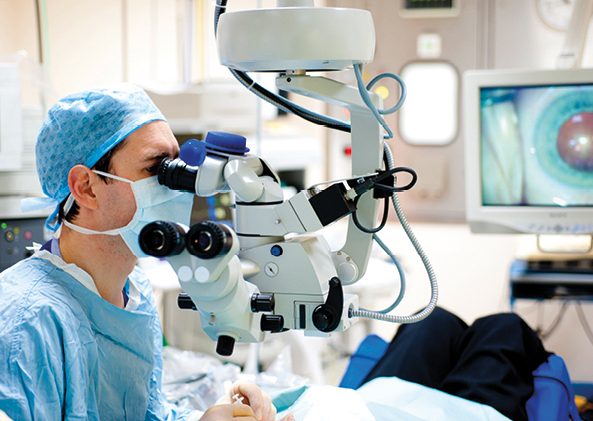We have provided evidence to the Academy of Medical Royal Colleges (AoMRC), which is responding to the UK COVID-19 Inquiry on behalf of all members. RCOphth Policy Advisor David Murray summarises the key points from our response, which recommends four actions to ensure UK ophthalmology services are resilient and able to deliver sufficient patient care and training opportunities during and after the acute stage of a future pandemic.
Inquiry overview
The UK COVID-19 Inquiry, announced in 2021 and having taken its first evidence session in 2023, is seeking to learn lessons from the pandemic with the aim of informing future preparedness and responses. The inquiry is split into multiple thematic modules. Currently, six modules have been announced with more to be added as the inquiry progresses in coming years.
We have responded to Module 3 which looks at the impact of the pandemic on the UK’s healthcare systems, including the healthcare consequences of the government and public’s response to the pandemic, the capacity of systems to respond to a pandemic and how this evolved, and patient experience during the pandemic.
To view the full Module 3 question sheet and our full response, please visit our Consultations page.
Recommendations to secure pandemic-resilient ophthalmology services
To inform our response, I spoke to RCOphth presidents past and present, College staff and ophthalmology clinicians on the frontline helping to maintain high quality ophthalmology care through the turbulence of the COVID-19 pandemic.
Taking on board their experiences and reflections in our submission, we set out four key recommendations to ensure the UK’s healthcare systems can be better placed to face a future pandemic:
- Better plan for the delivery of elective and outpatient services during the acute stage of a pandemic to continue appropriate levels of patient care.
- More effectively coordinate the delivery of additional independent sector capacity in the acute and post-pandemic stages, meeting patient need while supporting comprehensive NHS services.
- Accelerate integration between primary and secondary services to improve the availability and quality of care provided during a pandemic, including through provision of services in primary care and virtual settings.
- Ensure there is full consultation between NHSE, DHSC, and medical colleges when taking decisions which impact the delivery of services and expand this approach across all UK nations.
Better planning for the delivery of elective and outpatient services
While backlogs pre-dated COVID-19, the blanket shut-down of ophthalmology services during the initial phase of the pandemic exacerbated this problem and is an important reason why there are now around 650,00 people waiting for a consultant-led ophthalmology appointment in England alone – almost 10% of the entire NHS backlog. This shutdown of routine care also continues to affect training, where 31% of ophthalmology trainees are currently not on course to undertake their indicative number of procedures for their stage of training according to the GMC National Training Survey 2023.
There were similar challenges during the resumption of services following the acute stage of the pandemic. A lack of centralised leadership or coordination fostered a risk-averse approach to the reopening of routine ophthalmology care by NHS managers, which has contributed to long backlogs and rising workloads which are impacting patient care and driving down staff satisfaction.
Better planning for the delivery of routine elective and outpatient care by NHS provider organisations and eye units is central to avoiding these problems, with a focus on the maintenance of safe care during the acute stage of any future pandemic alongside more coordination during the resumption of services.
NHS provider organisations should also be encouraged to share the burden of care across different settings within their area, allowing patients to be treated as soon as possible in a setting with the most relevant sub-specialty expertise. Similarly, an appropriate level of training provision should be maintained by providers during the acute stage of a pandemic to minimise the impact on the development of the trainee workforce.
More effectively coordinate the delivery of additional independent sector capacity before and after a pandemic
While independent sector (IS) provision of NHS cataract surgery was rising steadily for several years before 2020, this provision expanded rapidly during the pandemic – approximately half of NHS cataract procedures are now delivered by IS providers, up from 34% pre-pandemic. While cutting into the cataract backlog, increased IS provision is posing sustainability challenges for ophthalmology services in terms of available training opportunities and funding for comprehensive NHS eye services, with 58% of NHS eye units reporting IS providers have a negative impact on patient care and services in their area. These challenges are driven in part by an uncoordinated approach to commissioning services and lack of effective mechanisms to enforce good practice.
In the event of a future pandemic, there must be a more coordinated regional approach to commissioning IS providers according to local patient need which is genuinely additional to NHS capacity and does not undermine the sustainability of comprehensive NHS services.
We welcome recent commitments by NHS England in the Elective Recovery Taskforce to report on the impact of the IS on NHS services but monitoring alone is not sufficient, we must see contractual provisions that ensure sufficient training is delivered by the independent sector and post-operative complications and an appropriate proportion of complex procedures are delivered by IS providers. These measures should ensure the challenges posed by IS providers to NHS services in England are reduced, which can be verified in NHSE’s regular impact monitoring.
Accelerate integration between optometry and ophthalmology services
Primary care optometry and secondary ophthalmology services worked much more closely during the pandemic, with more joint pathways as outlined in the RCOphth/College of Optometrist joint vision for eye care services and underpinned by the use of virtual clinics and video appointments.
With further technological innovation and investment, more routine ophthalmology care can be maintained during a future pandemic, leading to better patient outcomes and reduced post-pandemic backlogs. Innovations such as a national electronic eyecare referral system – as has been developed in Wales – and standardised imaging can reduce barriers to integrated care and promote a more seamless patient pathway. These innovations will also allow patients and clinicians more options in the diagnosis and management of eye conditions, which is particularly valuable when secondary care settings may be inaccessible due to a pandemic.
We must build on the foundational improvements outlined above to ensure near-future technological developments in areas such as artificial intelligence can be fully realised, expanding future capacity and improving patient outcomes.
Ensure the College is fully consulted when decisions affecting the delivery of services are taken across the UK
While there was strong engagement with RCOphth through meetings between College presidents and England’s Chief Medical Officer Chris Whitty, and other senior NHS England officials, consultation on critical decisions was poor. This high-level engagement was also lacking across Scotland, Wales or Northern Ireland.
In particular, the suspension of all routine elective care was taken with little to no consultation with RCOphth. Although we recognise that decisions had to be taken at pace with imperfect information, the consequences of this decision are still being felt today through long backlogs and worse patient outcomes. Likewise, the decision to re-open routine eye care services was taken with little consultation, resulting in hospital eye units frequently unable to restart surgery once given the green light to re-open.
It is imperative that in any future pandemic, medical royal colleges are properly consulted by all relevant UK governing bodies when decisions affecting the delivery of services are considered, such as a shutdown of routine elective care. High level-engagement that took place in England should be implemented in Scotland, Wales, and Northern Ireland for future pandemic-type events, with regular meetings between chief medical officers and royal college presidents.
Most importantly, this engagement should be underpinned by an appropriate level of consultation to ensure as much ophthalmology care provision can be maintained as is safe and reasonable, reducing post-pandemic backlogs and the risk of avoidable sight loss.
Conclusion
Hindsight is 20/20, which is why our response recognises that many decisions during the COVID-19 pandemic were taken in a vacuum of information and experience – key considerations such as the transmissibility and virulence of the COVID-19 virus were not known for some time and there was little to no institutional experience of managing a global pandemic within the UK.
Nevertheless, the approach to decision-making should have been more collaborative at the national level and more effectively delegated at the local and specialty level. This could have facilitated more informed strategic decisions while retaining efficiency and providing effective leadership for local clinicians and NHS departments.
The experiences, reflections and recommendations highlighted above must be acknowledged and lessons learned, so in the event of a future pandemic UK ophthalmology services are well placed to continue routine care, provide sufficient training, and avoid exacerbating already long backlogs. While recent initiatives to build more long-term sustainability into workforce planning and tackle ongoing backlogs are welcome, these efforts must accelerate. Tangible progress, whether through an expansion of specialty training places or the standardisation of ophthalmic imaging, must be made as soon as possible to ensure we can tackle immediate backlogs while securing sufficient long-term capacity to meet growing future demand.
Despite the immense difficulties posed by the pandemic, ophthalmologists across the UK stepped up. Whether redeployed to provide acute COVID care at personal risk, working around the clock to provide emergency eye care or finding imaginative ways to re-open routine services, we can be proud to have an innovative, hard-working community truly dedicated to providing the best possible care for all our patients, regardless of the circumstances.


